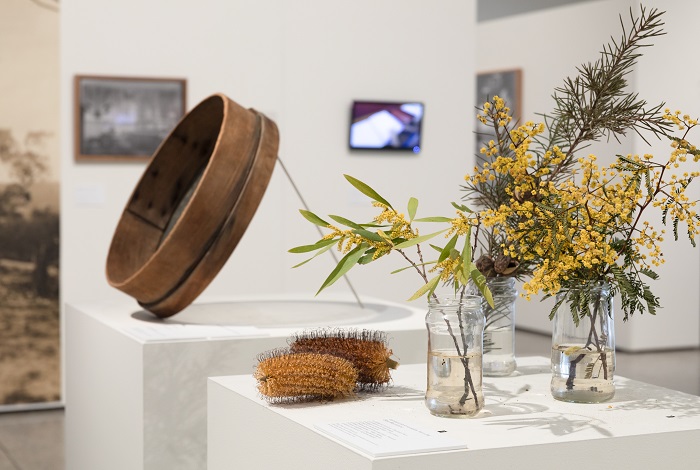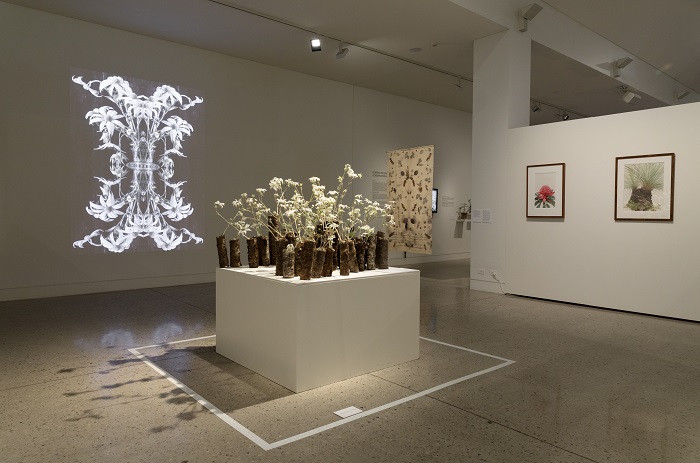Blue Mountains Botanica Exhibition view. Photo by Silversalt Photography.
Botanical art is perennially popular and I expected it to feature in Blue Mountains Botanica. However, I was immediately overwhelmed by text; words were everywhere, and not an artwork in sight. The font was too small and hard to read, and the text was poorly written. For example: was the 20th century collector’s name Ernest Constable or Contable? I saw it spelt both ways several times.
The ‘book on a wall’ approach to exhibition text has long been replaced in modern curatorial practice by a text hierarchy, with up to 300 words for an opening panel. Here, the opening panel (and at least five others) was about 700 words. Some panels even had footnotes! It takes discipline and skillful editing to stay within word limits but the reward is a better exhibition experience (see Louise J Ravelli, 2006, Musuem Texts: Communication Frameworks, New York: Routledge and Jennifer Blunden, 2017, ‘The Sweet Spot? Writing for a reading age of 12?’ Curator: Museum Journal, 60:3, 291-301. https://doi.org/10.1111/cura.12205) Eighty per cent of the text in Blue Mountains Botanica could have been cut and put in a free room brochure and on the website for people who wanted more detail.
Not only were visitors blasted with bad text, they were also told what to think. The curator’s role is to inform, not instruct: you want to pique visitors’ interest so they want to read more (see Tilden, Freeman (1977) Interpreting Our Heritage, 3rd edition, USA: University of North Carolina Press). You definitely do not want to offend or mislead them by saying that white, colonial botanical collectors ‘discovered’ certain specimens (just like Captain Cook did not ‘discover’ the east coast of Australia).

Blue Mountains Botanica Exhibition view. Photo by Silversalt Photography.
While the exhibition was drowning in text, sometimes I wanted it to be better distributed. For example, more than 250 words were written about each of the contemporary botanical artists, but there was no information about the early illustrators (apart from their birth and death dates) whose work was also on display. Surely visitors would find it interesting that Joseph Lycett was a recidivist convict, forgerer and alcoholic who was pardoned by Governor Macquarie because of his beautiful (often commissioned) paintings and that Sydenham Edwards started doing botanical illustrations at the age of 11 but never visited Australia? These early botanical artists deserve to be shown the same respect as the contemporary ones.
The first two galleries contain an impressive display of dried botanical specimens loaned from the Daniel Solander Library at the Royal Botanic Garden Sydney and the National Herbarium of NSW. These are displayed in high table-top cases inaccessible to children on their own. To make the exhibition a better experience for families, it would have been good to see at least a couple of the display cases at a child-friendly and wheelchair-accessible height. However, children were probably at the right height to see the labels, which were on the side of the cases, in tiny font (9-12 point when the industry standard is a minimum of 14-18 point), and in shadow (being at a 90-degree angle to the down lights) (See Georgia Rouette, 2007, Exhibitions: a practical guide for small museums and galleries, Melbourne: Museums Australia (Victoria), p.62-5). I gave up trying to read them.
Once I stopped trying to read the text and started ‘reading’ the exhibition visually and conceptually, my experience improved. In the first gallery, larger-than-life reproduction photographs of the white, colonial botanical collectors and illustrators grab your attention.

Blue Mountains Botanica Exhibition view. Photo by Silversalt Photography.
The second gallery details the history and process of botanical collecting. It was lovely to see some living and dried plant specimens on open display, some even at an accessible height. These were labelled and the living flowers will probably need to be replaced over the coming months. It is commendable that the curatorial team committed to this extra work, and also impressive that there were no ‘do not touch’ signs, as human instinct makes you want to feel the course, spiky leaves and smell the blossoms.
This gallery also has four short videos playing on TV screens and ipads with curated content. I watched several small ‘digital natives’ run confidently up to the ipads, which were mounted on the walls and tilted upwards at a 45-degree angle but alas, most couldn’t reach them and the mounts were not adjustable. While this exhibition was not advertised or curated specifically for children, it is common practice in galleries and museums to provide some labels for children, to have some objects at a lower height and/or to have activities that afford them a more meaningful experience. The way children engage with an exhibition is crucial: research shows that it is often their experience that will determine whether a family group returns (see Anne Grimes Rand and Robert Kiihne, 2010, ‘Experts, Evaluators and Explorers: Collaborating with Kids’ in Connecting Kids to History with Museum Exhibitions, D. Lynn McRainey and John Russick eds. California: Left Coast Press, p.77).

Blue Mountains Botanica Exhibition view. Photo by Silversalt Photography.
Two of the videos discuss the current conservation efforts to save endangered species, such as the Wollemi Pine, and how the connection that Aboriginal people feel to their land motivates them to ‘care for country’. The 700+ word text panel tells us that local Darug and Gundungurra people have been working with bush care and land care groups to rehabilitate the Blue Mountains bush. This not only strengthens the community’s commitment to the environment but also forges bonds between Indigenous and non-Indigenous locals. This is the beating heart of the exhibition, where it makes a subtle but strong political statement: it is only through appreciating the natural environment – for its beauty, biodiversity, and cultural significance – and by working together as a community, that we can ‘care for country’ for future generations.
The third gallery contains botanical artworks borrowed from contemporary artists. The layout is sympathetic to the artists and their mediums. The position of Edith Pass’ flannel flower installation, ‘Hollow Men’, in the centre of the space, with the backdrop of Jennifer Leahy’s ‘Timeslip’ HD digital artwork of flannel flowers was arresting. The inclusion of James Blackwell’s mesmerisingly perfect miniature artworks with laser-cut paper and seeds are a fine example of curatorial lateral thinking. Blackheath artist Julie Nettleton’s three watercolours were also exquisitely beautiful. However, hers were the only artworks which came close to being what I consider botanical art. Traditionally, botanical art shows the specimen in full, and then each of its parts – for example stamen, petals, stalk, leaves, roots – drawn separately. I was surprised that Marion Westmacott’s work was not included. Westmacott lives in the local township of Leura, was a botanical illustrator at the Royal Botanic Garden Sydney, and her work has been published in Curtis’ Botanical Magazine.
Would I recommend Blue Mountains Botanica? The answer is a qualified yes. Although the exhibition is well conceived, it is poorly executed. However, this exhibition is important, because it seeks to persuade visitors to appreciate the bush for botanical, cultural and environmental reasons; and to work with others to look after it – this is art that is relevant.
2 ½ stars ★★☆
Blue Mountains Botanica
25 August – 14 October 2018
Blue Mountains Cultural Centre, NSW





